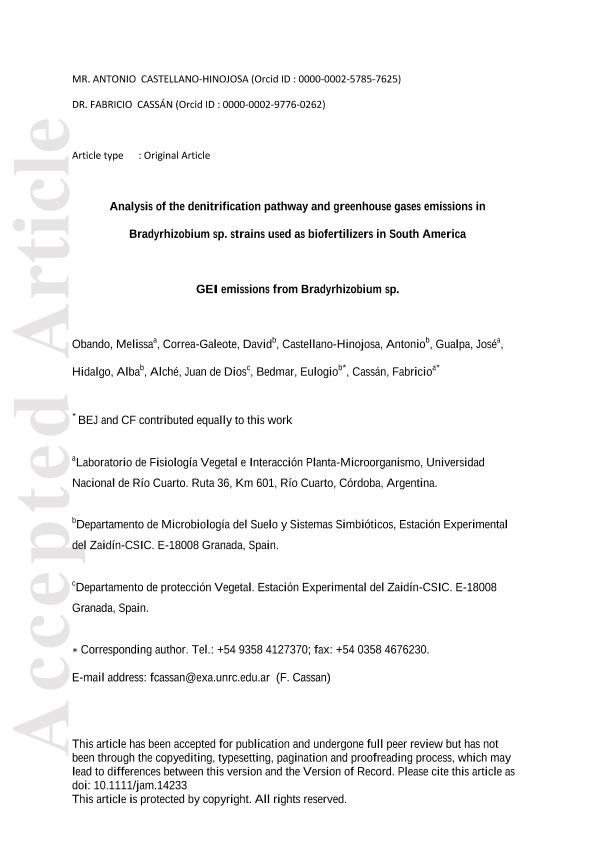Artículo
Analysis of the denitrification pathway and greenhouse gases emissions in Bradyrhizobium sp. strains used as biofertilizers in South America
Obando Castellanos, Dolly Melissa ; Correa-Galeote, David; Castellano-Hinojosa, Antonio; Gualpa, José Luis
; Correa-Galeote, David; Castellano-Hinojosa, Antonio; Gualpa, José Luis ; Hidalgo, Alba; de Dios Alché, Juan; Bedmar, Eulogio; Cassan, Fabricio Dario
; Hidalgo, Alba; de Dios Alché, Juan; Bedmar, Eulogio; Cassan, Fabricio Dario
 ; Correa-Galeote, David; Castellano-Hinojosa, Antonio; Gualpa, José Luis
; Correa-Galeote, David; Castellano-Hinojosa, Antonio; Gualpa, José Luis ; Hidalgo, Alba; de Dios Alché, Juan; Bedmar, Eulogio; Cassan, Fabricio Dario
; Hidalgo, Alba; de Dios Alché, Juan; Bedmar, Eulogio; Cassan, Fabricio Dario
Fecha de publicación:
06/2019
Editorial:
Wiley Blackwell Publishing, Inc
Revista:
Journal of Applied Microbiology
ISSN:
1364-5072
e-ISSN:
1365-2672
Idioma:
Inglés
Tipo de recurso:
Artículo publicado
Clasificación temática:
Resumen
Aims Greenhouse gases are considered potential atmospheric pollutants, with agriculture being one of the main emission sources. The practice of inoculating soybean seeds with Bradyrhizobium sp. might contribute to nitrous oxide (N2O) emissions. We analyzed this capacity in five of the most used strains of Bradyrhizobium sp. in South America. Methods and Results We analyzed the denitrification pathway and N2O production by B. japonicum E109 and CPAC15, B. diazoefficiens CPAC7, and B. elkanii SEMIA 587 and SEMIA 5019, both in free‐living conditions and symbiosis with soybean. The in silico analysis indicated the absence of nosZ genes in B. japonicum and the presence of all denitrification genes in B. diazoefficiens strains, as well as the absence of nirK, norC and nosZ genes in B. elkanii. The in planta analysis confirmed the N2O production under saprophytic conditions or symbiosis with soybean roots nodules. In the last case up to 26·1 and 18·4 times higher in plants inoculated with SEMIA5019 and E109 respectively, than in those inoculated with USDA110. Conclusions The strains E109, SEMIA 5019, CPAC15 and SEMIA 587 showed the highest N2O production both as free‐living cells and in symbiotic conditions in comparison with USDA110 and CPAC7, which do have the nosZ gene. Although norC and nosZ could not be identified in silico or in vitro in SEMIA 587 and SEMIA 5019, these strains showed capacity to produce N2O in our experimental conditions. Significance and Impact of Study This is the first report to analyze and confirm the incomplete denitrification capacity and N2O production in four of the five most used strains of Bradyrhizobium sp. for soybean inoculation in South America.
Palabras clave:
Greenhouse gases
,
Denitrification
,
Bradyrhizobium
,
Inoculants
Archivos asociados
Licencia
Identificadores
Colecciones
Articulos(CCT - CORDOBA)
Articulos de CTRO.CIENTIFICO TECNOL.CONICET - CORDOBA
Articulos de CTRO.CIENTIFICO TECNOL.CONICET - CORDOBA
Citación
Obando Castellanos, Dolly Melissa; Correa-Galeote, David; Castellano-Hinojosa, Antonio; Gualpa, José Luis; Hidalgo, Alba; et al.; Analysis of the denitrification pathway and greenhouse gases emissions in Bradyrhizobium sp. strains used as biofertilizers in South America; Wiley Blackwell Publishing, Inc; Journal of Applied Microbiology; 127; 3; 6-2019; 739-749
Compartir
Altmétricas



